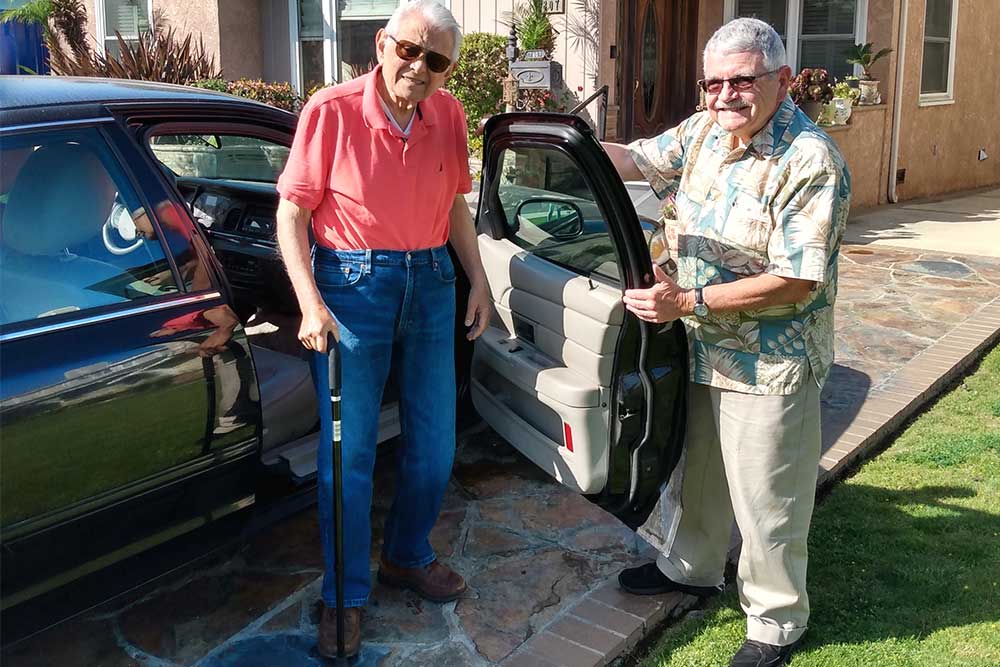
Tim Roberts helping out a neighbor. Photo by K. Kyger. Courtesy of author.
In the film industry, when a new movie flops, the studio often responds with layoffs, in part to cover the stiff losses. Thus, in spring 2015, after 39 years with Columbia Pictures—by then Sony Pictures—I found myself with lots of free time at my disposal.
I decided to use that time in part to volunteer; I felt too work-oriented to abide being put out to pasture. While tutoring with the adult literacy program at my local branch library, a flyer for a neighborhood group called Westchester Playa Villages, later renamed Westside Pacific Villages (WPV), caught my eye. “Neighbor Helping Neighbor” and “Serving Your Community” and “Become a Friend”—the upbeat, dynamic, and thoroughly sociable tone intrigued me.
I learned that WPV matches aging neighbors (who pay a small fee) with local volunteers who help them in a number of different ways: making short visits, being a walking buddy, or driving to doctor’s appointments and the like. WPV is based in L.A.’s Westside but is part of a national “village movement” to help people age in place.
I knew the neighborhood well and enjoy in-city driving. Before long, I was signing into the Assisted Rides software that WPV uses in order to drive around my neighbors who no longer are able to drive themselves.
I am happy to offer myself as a responsible person and a comfort to someone who is nervous about their appointment and concerned about getting there promptly and safely. I’m usually available to stay with the person I’m driving during their visit and accompany them back to my car for the ride home.
These drives also can be ideal times for relaxing conversation. I’ve had many substantive discussions, discovered many common interests, and heard numerous extended stories of past travels and family histories.
I’ve even discovered that some neighbors have a connection with the early glory days of Hollywood. One, a soft-spoken grandmotherly sort, shared with me that she played a flower girl in the wedding scene in the movie Camille. She didn’t want to tell me how long ago that was, but since I knew that the film came out in 1936, I could easily do the math. Her other proud accomplishment: teaching English lessons to the actress Leslie Caron at the school for child actors on the MGM lot.
Another neighbor related to me her experience at the Japanese American internment camp at Heart Mountain, Wyoming in the 1940s. She had an incredible recall of the daily routines of camp life. One powerful recollection: getting a day pass to go into the local town to do shopping and seeing stores with “No Japs” signs in the windows.
Sometimes it’s challenging to make conversation, but for the most part I’ve found that my neighbors enjoy the opportunity to have a rich, unexpected, one-on-one discussion about a range of topics.
And I feel I’ve gained insight into how to listen to personal sharing, and how to share about myself in response to the openness neighbors show to me. Some folks are very expansive when talking about their family, and seem eager to share even casual details. Other members are more outward-oriented and want to discuss current events—in which case I prepare myself in advance with the latest breaking news and the political scene in general—which can be very challenging but does keep me on my toes.
There’s also the emotional state of the passenger to contend with. I often begin rides by reassuring a nervous neighbor by calmly saying, “I know where we’re going, the most direct route, and the best place to park. You’re in good hands with me.” But one day, I was driving someone for the first time, in a rush to see her doctor because she had run out of pain medication. She was in something of a nervous frenzy and stayed in an agitated state after she got into my car. I allowed her nervousness to make me nervous. In my haste, I scraped the side of my car against a water spigot jutting out from the back wall of her home. Nothing else went wrong that day—and my driving record (and car) have been pristine ever since.
These driving experiences also have afforded me opportunities for reflection and insight. I had always associated trips to doctor appointments, hospital check-ins, and lab testing with sick people or being sick myself. But after countless drives, these destinations have become normalized. They feel as natural as going to the library. Well, almost.
I’ve come to feel a oneness with the neighbors I have come to know, and a keener awareness of the aging process we all share. In living through so much time with them, I realize I’m going through the same stages. It’s the sensation of “We’re all in this together.” What an empowering realization, but it’s also a humbling one.
A final irony for this movie aficionado is that I no longer need to go to a darkened theater and gaze at a big screen in search of high drama. Whether it’s a World War II-era family story or anxiety about current events or good news from a doctor, I experience it all from a decidedly front row seat.




Send A Letter To the Editors